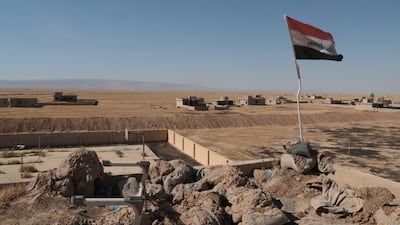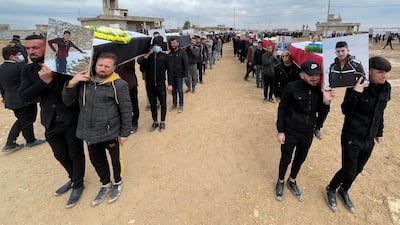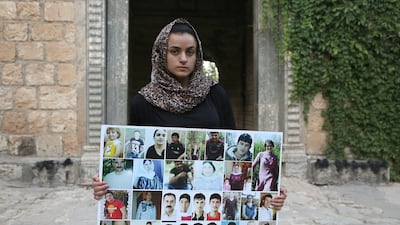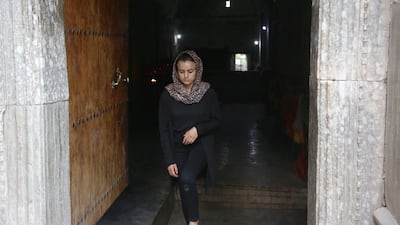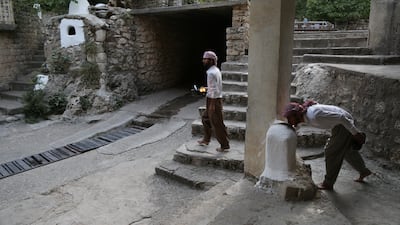Nayef Jasso had lived all his life in the remote Yazidi village of Kocho, which was established by his father. But he happened to be in the city of Duhok during the first days of August 2014, as ISIS swept through northern Iraq.
His brother Ahmed, Kocho's chief, was at home as phone calls came in from villages closer to the cragged peaks of Mount Sinjar in the early hours of August 3, describing mass killings and women and children being loaded on to lorries to be taken to slave markets in Mosul.
“I told him I would come back to Kocho, and he refused. He said, 'stay there, perhaps you find us somewhere to stay or make a deal to save the village',” Mr Jasso, 64, said.
Ahmed was killed along with many villagers a few days later, as ISIS almost wiped Kocho off the map in one of the worst crimes of what would be later recognised as genocide against the Yazidi religious minority.
Mr Jasso spent days pleading with anyone he could, including the Iraqi government, to make a deal to save the village but could only return to Kocho three years later, after fighting to free it from ISIS occupation.
Survivors marked the 10th anniversary of the attack on Thursday, mourning at a newly built cemetery in the ruins of the abandoned village, surrounded by mass graves.
After encircling the village for two weeks, ISIS militants on August 15 ordered the 1,700 inhabitants to gather in the school, where they were separated by age and gender. Men, older boys, and older women were shot, and the rest taken as slaves and child soldiers.
A total of 511 villagers have been confirmed killed or are still missing, according to statistics given to The National by Nadia's Initiative, established by Kocho survivor and Nobel Peace Prize laureate Nadia Murad, with the remains of 151 identified and buried in the cemetery.
Nineteen people survived being shot into 19 mass graves in and around the village, close enough for terrified women to hear shots ringing out as they were held in the school.
Thikran Mato, Mr Jasso's nephew, was 15 when the massacre took place.
“At the school gate, one of the ISIS members put his gun between me and my father and told me to go back to my mother, because I was young at the time. My father smiled and looked at me, I knew then that I would never see him again,” he said.
He is still waiting for his family's remains to be identified.
“Only 150 [sets of remains] have been returned out of about 500 people. This makes our life very difficult. I buried my father and now I am waiting for my brother's bones and the rest of my family,” Mr Mato told The National from Germany, where he resettled after being freed from captivity in 2016.
August is a particularly heavy month for Iraq's Yazidi community, followers of an ancient and closed religion. Survivors gathered in Sinjar on August 3 to mark 10 years since the start of the 2014 genocide, while August 14 marked 17 years since a twin bombing in the Yazidi towns of Tal Ezeer and Siba Sheikh Khidr, in Nineveh governorate, northern Iraq, killed almost 800 people.
No one claimed responsibility for the 2007 blasts, which occurred at a time of high sectarian tension.
While most people from the Sinjar region remain in camps and cities in Iraq's semi-autonomous Kurdish region, more are returning to their former homes – except for Kocho. Three years after plans were announced to build a new village on land given by the Iraqi government, survivors from the village largely remain in tent camps.
“The desire from the community is just to have a place to go back to. For the past several years people have been returning to most villages in Sinjar, except Kocho. An alternative is not yet there.” said Abid Shamdeen, co-founder of Nadia’s Initiative.
Plans have been drawn up with the UN's International Organisation for Migration, USAID and a team of engineers and architects, who are ready to begin work. The new village will be some distance away from old Kocho.
“It is traumatising and very difficult for the community to go back and live in the same village, especially as the mass graves were either inside Kocho or right outside, and with what happened in the school, and now. They feel it would be very difficult for those who survived, and are still living in Iraq, to go back,” said Mr Shamdeen.

On Sunday, a mother from Kocho and her child were released from Al Hol camp in eastern Syria – where families linked to ISIS are detained – and greeted by their surviving family at the border the following day. The girl, now 10, was three months old when taken into captivity during the August 15 massacre.
More than 6,400 Yazidis were taken captive during the genocide, including from Kocho. According to Mr Shamdeen, 2,692 are still missing, half of whom are women and the rest young boys.
Foreign initiatives to rehabilitate women and children returning from ISIS captivity have largely ended, and most go to live in camps for displaced people in Iraq's Kurdish region. Mr Jasso says Kocho’s remaining survivors are scattered across the Kurdish region and Sinjar villages, such as Tel Qasab.
On the long journey from Baghdad to Kocho, Mr Jasso recalls government meetings over the project, and says he hopes to lay the first stone of new Kocho next month.
“This is for Kocho, for the survivors who stayed in Iraq and those who went abroad. We were 1,700 people and now we're scattered over four or five continents.”
He is one of only a few people to return to the deserted village, where those who have come back guard the cemetery and the mass graves. No families have returned, and the school now lies untouched, lined with the portraits of villagers killed or kidnapped by the terrorist group.
“The main thing I want is the school to be a museum. This is our right,” said Mr Jasso. “What happened there was a catastrophe. It’s now a historical landmark.”
His nephew agrees that what remains of Kocho should be preserved as a lesson on what happened. But he has reservations about plans for a new village.
“They are planning to build a new Kocho, but without the people of Kocho,” said Mr Mato. “How can I live in the same area where my father, brother and friends are buried? But there are people from Kocho who need this, and need homes.”
He said what remains of the village, the mass graves and “demolished houses”, should now be a historical site.
“It is the place where an entire village was killed and taken captive, just because they were peaceful people.”
Fighting through loss
Ryan D’Souza, who has worked in genocide and atrocity prevention for more than a decade, first visited the village in 2019. He was shown around the remains of the Kocho by Mr Mato, as they began to document the destruction for a virtual reality project, showing the aftermath of the massacre, that has now toured the globe.
“You enter and the whole village is destroyed. There’s an eeriness. You see the grass growing in different directions. It doesn’t feel like it was inhabited,” Mr D'Souza, founder of the project, told The National from his home in London.
“The one thing that was basically intact was the school, which is harrowing. That’s the part that is really shocking. There’s just silence.”
His project follows the stories of Yazidis taken into captivity as slaves and child soldiers, and walks participants around the crumbled remains of Kocho, where ISIS graffiti is still scrawled on the walls.
Mr Mato and Mr D'Souza have brought the story of Kocho to a wider audience at foreign parliaments and UK schools, and parliaments and universities in Iraq and its semi-autonomous Kurdish region.
“Showing it in Baghdad, people understandably see their own suffering because everyone has suffered in Iraq. It's been 10, 20, 40 years of awful, genocidal crimes.”
“It is interesting to show them this VR – to show them what genocide, not just in terms of the sexual crimes [against Yazidis], but what genocide means by complete targeting and elimination,” said Mr D'Souza.
“We've shown it to educators [in Iraq] and want to take it to high schools. We know it works. Going there and being there is the best way of learning and empathising and having an indelible mark left on people, but this is the first step towards that.”
Back in the village, Mr Jasso now serves as its chief in place of his brother. He prepares for Thursday's memorial, as locals visit graves with candles.
“I’ve not given in to this loss,” he said. “I've held my nerve, I've helped free captives and free Kocho, and now I'm back to guard the cemetery and the village.”



